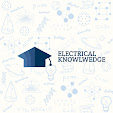CHARGING [CHARGING BY INDUCTION]
CHARGING BY INDUCTION
CHARGING BY INDUCTION
When we touch a pith
ball with an electrified plastic rod, some of the negative charges on the rod
are transferred to the pith ball and it also gets charged. Thus, the pith ball
is charged by contact. It is then repelled by the plastic rod but is attracted
by a glass rod which is oppositely charged. However, why an electrified rod
attracts light objects, is a question we have still left unanswered. Let us try
to understand what could be happening by performing the following experiment.
1. Bring two metal
spheres, A and B, supported on insulating stands, in contact.
2. Bring a positively
charged rod near one of the spheres, say A, taking care that it does not touch
the sphere. The free electrons in the spheres are attracted towards the rod.
This leaves an excess of positive charge on the rear surface of sphere B. Both
kinds of charges are bound in the metal spheres and cannot escape. The left
surface of sphere A has an excess of negative charge and the right surface of
sphere B has an excess of positive charge. However, not all of the electrons
in the spheres have accumulated on the left surface of A. As the negative
charge starts building up at the left surface of A, other electrons are
repelled by these. In a short time, equilibrium is reached under the action of the force of attraction of the rod and the force of repulsion due to the
accumulated charges. The process is called induction of charge and happens
almost instantly. The accumulated charges remain on the surface, as shown, till
the glass rod is held near the sphere. If the rod is removed, the charges are
not acted by any outside force and they redistribute to their original neutral
state.
3. Separate the
spheres by a small distance while the glass rod is still held near sphere A. The
two spheres are found to be oppositely charged and attract each other. (iv)
Remove the rod. The charges on spheres rearrange themselves. Now, separate the
spheres quite apart. The charges on them get uniformly distributed over them.
In this process, the metal spheres will each be equal and oppositely charged.
This is charging by induction. The positively charged glass rod does not lose any
of its charge, contrary to the process of charging by contact. When electrified
rods are brought near light objects, a similar effect takes place. The rods
induce opposite charges on the near surfaces of the objects and similar charges
move to the farther side of the object.


No comments:
If you have any doubts, please let me know